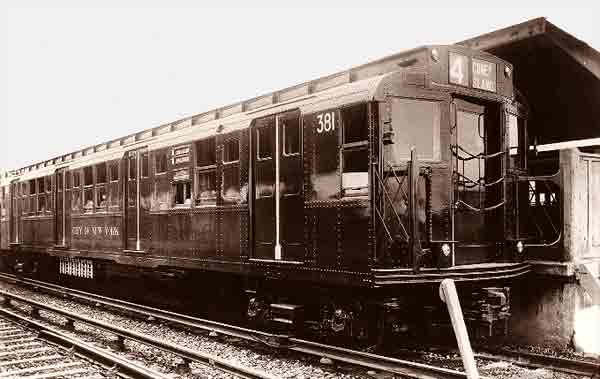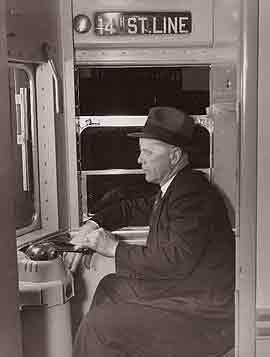Back to the Future—
New York's Lost Transit Legacy
Page 3

Sturdy but blandly
utilitarian ,
the IND bought more than 1700 of these R1-9 subway cars. Borrowing
liberallly from the BMT's 1925 Triplex design, it
set the conservative tone for New York City subway design for decades
after the end of the BMT. This view is at Coney Island where car 381 and others
were tested in revenue service on the BMT's Sea Beach Line from July to
November, 1931, before the IND opened. Paul Matus
Collection
The Nation’s
Transit Leader
By the late 1920s, with the BMT and IRT systems
mostly in place, the IND system being built and additional private
streetcar and bus lines blanketing its streets, New York City was the
center of mass transit in the U.S., as it still is today. One difference
between the 1920s and our new century is that mass transit in general, and
rail transit in particular, was a vibrant and mostly free enterprise
industry.
The leader in this giant industry
was New York’s BMT. What the IRT and IND lacked the BMT had in abundance:
a vision of transit as an attractive product, and the passenger as a
customer.
The subway equipment was made of
steel and was new as far as rapid transit equipment went (most around a
decade old or less), but the elevated fleets included wooden equipment
from the turn of the century and earlier. These wooden cars presented a
double problem: safety considerations, including fire and
crash-worthiness, led to the removal of wooden equipment from subway
tunnels, while the older elevated structures were incapable of handling
heavier but safer steel cars.
The IRT’s
solution was a non-solution: its own subway lines and the elevated lines
it leased from the Manhattan Railways were virtually separate systems,
with some interoperation at the far reaches of the system in the Bronx and
Queens. It made only incremental changes to its elevated equipment, such
as the fitting of doors to cars that previously used labor-intensive gates
for access.
The City’s cure was worse than the disease for the private
companies. Its IND undermined the private companies, both literally and
figuratively, by building subways to compete with the elevated lines. For
example, the 8th Avenue subway competed head-to-head with the IRT’s
9th Avenue el, and the Fulton Street
subway competed with the BMT’s bread-and-butter Fulton Street
Line.
This subway replacement option was not
within the private company’s reach as the IND, then being constructed
strictly from the public purse, did not worry much about the market at
all. This was to result in a magnificently engineered system that was
sometimes overbuilt. An ambitious “second system” was proposed in 1929 but
the first system had already ballooned New York City’s rapid transit
debt.
The BMT not only had a large elevated system, but one which
was much more tightly integrated with its subway system. It had no elevateds in
Manhattan, as the IRT did, to bring its elevated line passengers to the heart
of the City. It knew that, with the IND getting the City’s construction money,
future capital construction would be limited. The BMT had ambitions—it wanted
to tie its Fulton Street Line to its subway system at DeKalb Avenue. It wanted
to bring subway service to the farther reaches of its system. It wanted to
eliminate the dangers of steel and wooden equipment operating on the same
tracks. And it didn’t want to upgrade its elevated fleet with
patchwork solutions. It wanted to replace the fleet with the most modern
equipment in the country, but how?
In 1927 the Transit
Commission, which could rule on the suitability of equipment to run on the
City’s rapid transit lines, appointed a committee of engineers to
determine the feasibility of constructing a steel car light enough to
operate on the older elevated lines. After thorough study, they decided
such a car was not feasible.
Continued on page
4
 |
The Bluebird used advanced
controls. Both acceleration and braking was regulated by
this Cineston controller from General Electric.
Paul Matus
Collection |
The Third Rail and The Third Rail
logo are trademarks of The Composing Stack Inc.
|


